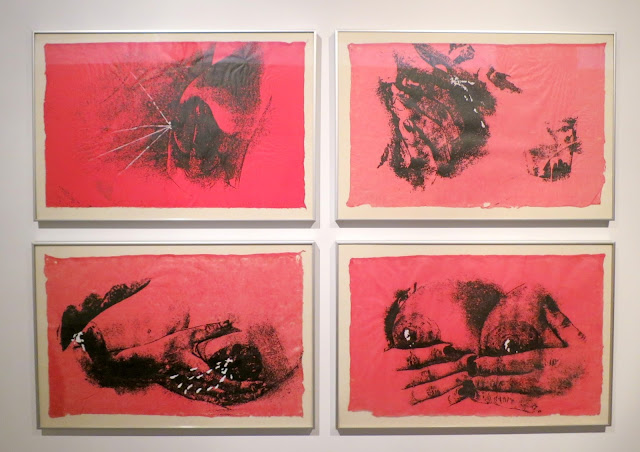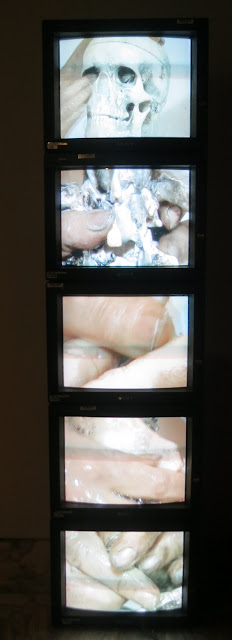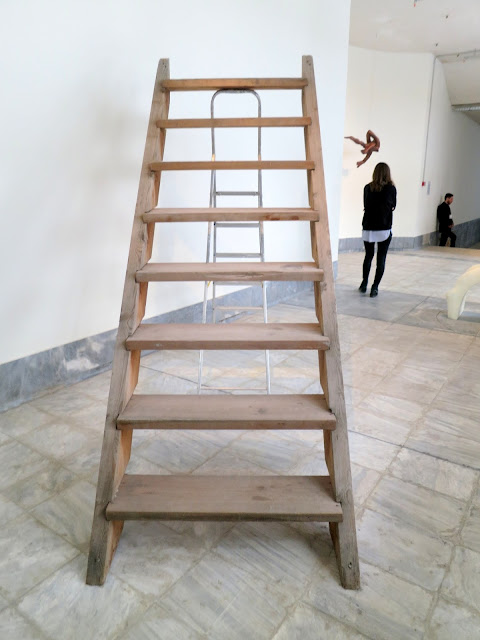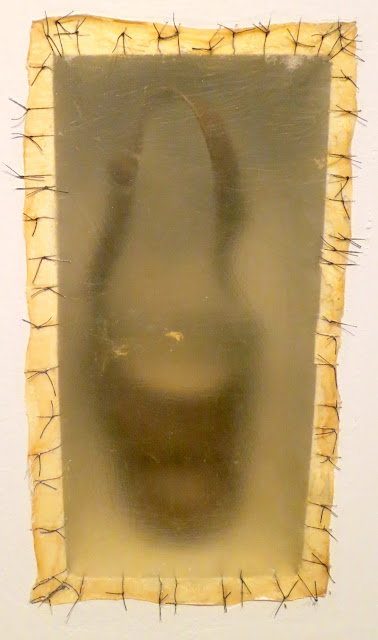Flying Over the Abyss, exhibition organised by NEON, at the Athens Conservatoire.
This exhibition was brought to the Greek public by Neon, an organisation founded and funded by collector Dimitris Daskalopoulos. It is 'a nonprofit organisation that works to bring contemporary culture closer to everyone. It is committed to broadening the appreciation, understanding and creation of contemporary art in Greece and to the firm belief that this is a key tool for growth and development... Neon breaks with the convention that limits the contemporary art foundation of a collector to a single place. It acts on a multitude of initiatives, spaces and civic and social contexts. It seeks to expose the ability contemporary art has to stimulate, inspire, and affect the individual and society at large'. (from the Neon website )
We were very impressed by the aims of this organisation as well as the way the exhibition was curated. Entry was free of charge and in every room guided tours were provided.

The organisation also runs a series of educational programmes aimed at school children of all ages under the title of 'Is this art?' We were given a list of their educational programme which is extensive. Groups of (extremely well-behaved) children were dotted around the exhibition, looking, listening, taking notes and drawing.
* * *
The exhibition 'Flying Over the Abyss' was hosted in the basement of the Athens Conservatoire, a cavernous space that consists of large gallery spaces as well as smaller, intimate rooms. There were signs directing us around the space and everyone was very helpful.
The exhibition itself was one of the best I have seen in a while. Again from their website: 'The selection of the participating artists both international and Greek is influenced by 'Ascesis: the Saviors of Gods', the spiritual exercises written by Nikos Kazantzakis. The exhibition will establish a creative dialogue among the artists' works and the essay, tracking the enlightenment of a human life's pathway, from the time of birth till death. The original manuscript of Ascesis will be on display'.
Mike Kelley, Glorious Wound, 1986 (acrylic on cotton with wig)
Mike Kelley, Untitled, 1990 (two rag dolls sewn together)
Louise Bourgeois, The Birth, 2007, (gouache on paper)
Ana Mendieta, Untitled (Blood Sign #1), 1974 (silent film)
In this work, Mendieta smears blood on the wall delineating her own body and morphs her own selfhood as an artist painting. At the end she writes in blood 'there is a devil inside me'. The shocking, bloody gesture harks back to shamanic sacrifices, but clearly heralds another magical event of traumatic birth: I, The Artist am being born.
Hans Bellmer, La Demi-Poupee, 1972, (wood and paint)
The distorted doll signifying a grave dysfunction in the wake of some painful and catastrophic dismemberment, evoking deeply rooted social and (perhaps personal) psychoanalytical traumas.
This iconic Logothetis work is one of the works that originated from his famous multi-day performances at the seaside resort of Porto-Rafti in 1972. During those days he buried pieces of fire-coloured canvas in the earth, submerged them in the water of the sea and then dried them by hanging them in the wind: the four Pre-Socratic elements of Greek philosophers. He then wrapped the canvas
It is also worthwhile noting the connection with Kazantzakis in the context of this exhibition who defined his unique concept of Razza (which translates poorly as Race) as the agglomeration of archetypal influences of ancestry, upbringing, history, culture, geography, all influential baggage that impacts on an individual's psyche. As such, it is fascinating to observe that Logothetis is creating art through his sublimation of Ancient Greek philosophy, a component of his Razza.

Sherrie Levine, After Courbet: 1-18, 2009, (18 postcards on mat board)
Sherrie Levine's After Courbet, is another example of the artist's longstanding conceptual strategy of appropriating pre-existing important works by male artists from the realm of art history. (For more information on the artist go here and here ). In this case, she has framed 18 postcards from the museum shop at the Musee d'Orsay which depict the famous Gustave Courbet painting L'Origin du Monde from 1866.

This strategy speaks to questions of the origin of creativity, the role of the artist in a world already full of images, as well as our consumption of great works through the process of reproduction. Last but not least, it is a full frontal assault on our eyes forcing us to view where we came from.
Heidi Bucher, Turfalle, Oberhuhle (Ahnenhaus), 1980-82, (mother-of-pearl, latex, wood, textile)
In this work Bucher has cast yet another architectural element, a doorknob from the house she grew up in. The act of opening a closed door is rife with emotional content: behind a closed door lurks a dark unknown ... perhaps the abyss of one's inner soul? Or alternatively an escape towards a new beginning? And especially since this is the parental abode, also perhaps the process of unlocking the dark rooms that contain the trauma of childhood?
Robert Gober, Untitled, 200, (lithograph, screen print, mixed media on paper)
Vlassis Caniaris, The Big Swing, 1974, (mixed media)
The Big Swing incorporates one of Caniaris' emblematic dolls but further morphs into a large-scale installation. The doll is framed, conceptually and formally, by a wooden construction that serves to impart the feel of a leaping movement from a swing. The framework with its background curtain establishes a strong theatrical character, a framed presentation of the doll. At the same time, the wooden construction has a somewhat threatening presence as if the viewer is confronted by a scaffold for a hanging. The figure itself and its forward uplifting swing can be construed as a reference to the ancient Greek sculpture of the Victory of Samothrace.
One has to situate the work within the context of Caniaris' wider practice and his preoccupation with the phenomenon of Greek emigration, a population movement fraught with existential, social and political upheaval. The Big Swing encapsulates a brave move forward (the victorious reference) but nevertheless a dangerous move into the unknown (the threat of the scaffold).
You can see more of Caniaris' work here
Aliki Palaska, Breathing Space, 2015 (mixed media)
Palaska breathed in and out with her tummy. The space between her in and out is cast and creates her Breathing Space. An array of materials serves to embody the work.
Robert Gober, Untitled, 1988, (silver gelatin print)
Kiki Smith, Untitled, 1980-82, (four light boxes)
The disembowelled innards of Untitled, 1992 are silently hanging from the ravaged belly of a figure which however, is miraculously struggling to maintain an upright, alive position. It is still or at least for the moment persevering its selfhood.
Kiki Smith, Untitled (Pink Bosoms), 1990-92, (set of 4 screen prints with gouache on rice paper)
In this work a woman's hands can be seen squeezing her breasts and ejaculating milk. This act concentrates on the physical presence of the primal bodily liquid of nourishment but the whole vision is presented through a reddish-pink film of colour, a subtle allusion to blood and mortality - the other bodily liquid. Milk that nourishes and blood that signifies the end of mortality, the two liquids establish a dance of opposition that encapsulates the whole struggle of life.
Marina Abramovic, Cleaning the Mirror #1
In this video-installation Abramovic is meticulously cleaning a human skeleton. This is inspired by a Tibetan Buddhist practice where monks have to dance and sleep with corpses so that they come to accept death, the great unifier.

Creativity into Eternity:
Ioanna Pantazopoulou, Reconfigured Etiquette, 2012, (tables, chairs, glasses, plates, cutlery, expanding foam, wire, crystal)
A frozen explosion of a Big Bang moment. It is the instant when all the objects that comprise a typical dinner environment are caught in an outwards trajectory of arrested moment.
looking closer
Gary Webb, The Creator Has a Master Plan, 2004, (aluminium, rubber, steel, fabric and fan)
Matthew Barney, Drawing Restraint 9, 2005
Whaling and the affinity of the Japanese soul to it; Japan's WWII defeat; the geopolitical importance of the oil industry are some of the themes in this video installation.
Mark Wallinger, The Underworld, 2004, (21 channel video installation)
We entered a darkened room where 21 inverted TV monitors created an extremely loud cacophony of sound. Based on the 1982 BBC TV recording of Giuseppe Verdi's Requiem, the musical performance plays on all 21 TV monitors: it starts at staggered points for each monitor thereby rendering a dissonant aural chaos of the concert.
Requiems are musical pieces that are devoted as a sort of prayer for the salvation of a deceased soul. Wallinger appropriates the famous creation but disassembles it and gives it a new contemporary form. The cosmic cacophony of The Underworld with its Duchampian inverted monitors reenacts a moment of sublime creation. The mixing of the staggered soundtracks conjures an internally endless discord of sound evoking a Dantesque Purgatory. The upside down figures point to the title's Underworld and the monitors on the floor seem to signify that those lives are at rock bottom, a hell of great proportions. The humans mourning for a lost soul cannot sink lower into the abyss of grief.
Touching the Other:
Asta Groeting's practice revolves around positioning objects and the empty spaces between them whose presence/absence is always emotionally laden. She casts objects and plays with the positive/negative relations that are configured. Her sculptures are time-frozen snapshots whose voids speak of a felt presence in tones of intimacy, memory, loss. In this sculpture the visitor faces 'the void between two people along with all the unexpressed, inexpressible and hidden issues that relationships involve'.
Lynda Benglis, Tres, 1976, (white mesh, cotton bunting, plaster, sprayed aluminium and copper)
In Tres, she rolled pieces of canvas around a metallic mesh into limb-like structures, knotted them into shape and then plastered and spray-painted them.
Bruce Nauman, Untitled (Hand Group, 1997, (phosphorous bronze)
Maro Michalakos, Happy Days , 2012, (mixed media)
Most of Michalakokos' oeuvre revolves around performatively shaving bits of burgundy velvet with a scalpel, creating images. After years of collecting the shaved remnants of previous artworks, she decided to make this installation.
Costas Tsoclis, Danger-Risk of Death, 1968, (iron, rubber, light)
life-threatening.

Ana Mendieta, Untitled (Gunpowder Work #2), 1980
A reference to the Greek tradition of Anathymata of erecting small sacred structures at the site of a fatal accident, as a commemoration to the dead.
Mark Wallinger, Threshold to the Kingdom, 2000, (projected video installation)
The Medusa was a French naval ship that was shipwrecked on a voyage to Senegal carrying around 400 French soldiers. 150 of them managed to survive on a raft made from debris of the ship. After a week only 15 of them managed to survive, the rest having died of hardship, accidents, murder and cannibalism. On the 13th day, the ship Argus rescued the ten survivors who had remained and returned them to France, where they related their shocking story.
Doris Salcedo, Atrabiliarios, 1995, (mixed media)
Over the years Salcedo has mounted a sustained critique of the political conditions in her native Columbia. Drawing on the bloodied history of her country she manages to create works that transcend the political and speak on a much more personal and emotional level about loss, oppression and death.
In Atrabiliarios she has entombed shoes of missing persons, victims of the Columbian junta, members of her family being also such 'disappeared' victims. Formally she achieves the visual effects of a discernible shoe, but with the translucent animal skin dulling the focus of the object, the luminosity toned down, the abject shoes are fading away into posterity. This is animal skin hand-sewn onto a miniature grave box - can the creative act of sewing ever heal the trauma of death of a loved one?


























































Gosh! One of those exhibitions that needs many visits, and concentration on small parts. I have to keep coming back to your post. Thanks.
ReplyDeleteIt was wonderful, Olga: so many treasures under one roof and the whole exhibition was so engrossing. I did not know anything about the exhibition or NEON, we were on the bus when we saw the poster and decided to go - we just made it, the exhibition is now over.
Delete